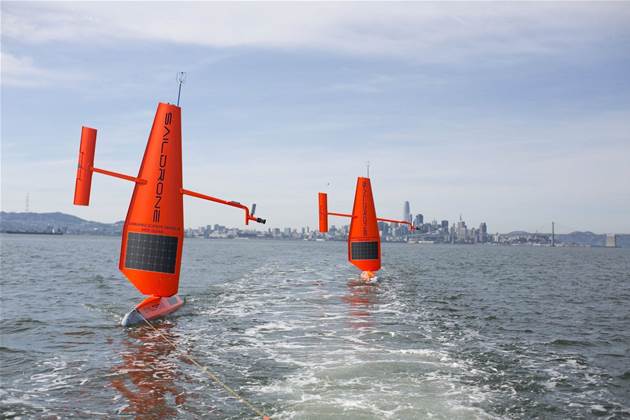The CSIRO has partnered with San Francisco-based Saildrones to launch a small fleet of unmanned sea drones for oceanic research, replacing crewed ships to reach rougher waters than was previously possible.

The three Saildrones are windpowered and can stay out to sea for up to 12 months at the time.
Saildrones are approximately seven metres long and 4.6 metres tall, with a draught of 2.15 metres. The drones weigh around 544 kilograms, and have a payload of 113.4 kg.
They are remotely controlled and travel at three to five knots (5.5 to 9.3 kilometres) per hour, and can also be halted on one spot for specific survey pattern needs.
Sensors aboard the Saildrones measure wind speed and direction, air temperature, pressure and humidity, and other atmospheric conditions.
Oceanic surface and sub-surface measurements such as wave heights, currents, water termperature and salinity are also taken, along with marine mammal presence and sonar pings for fish biomass.
Data captured from the Saildrones is transmitted back to shore stations via satellite. It can be accessed and visualised via the company's application programming interface.
The CSIRO will manage a fleet of thre Saildrones deployed from its operations in Hobart.
"This research partnership comes at a critical time for the marine environment, and at a time when technological innovation in the marine sector is booming," CSIRO research group leader Andreas Marouchos said in a statement.
"The devices gather fundamental information about our oceans and climate using a powerhouse of ocean chemistry, meteorological and marine acoustic sensors."
Saildrone was founded in 2012 by Briton Richard Jenkins, who in 2009 set a new windpowered world speed record of just over 203kph.
The company has worked with the US National Oceanic and Atmospheric Administration and attracted million dollar funding from former Google chairman Eric Schmidt.


_(22).jpg&h=140&w=231&c=1&s=0)


.png&h=140&w=231&c=1&s=0)



_(26).jpg&w=100&c=1&s=0)

 iTnews Executive Retreat - Security Leaders Edition
iTnews Executive Retreat - Security Leaders Edition












_(1).jpg&h=140&w=231&c=1&s=0)



